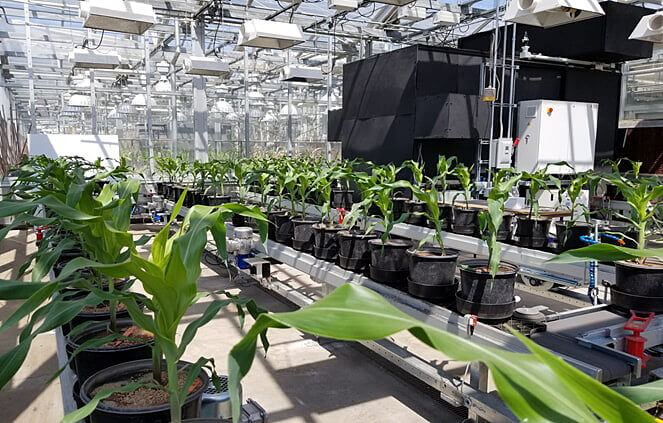February 27, 2018
Greenhouse 'conveyer belt' could advance food production, address looming global food crisis
WEST LAFAYETTE, Ind. – Purdue University researchers have created a greenhouse on campus featuring a new automated conveyor system that keeps plants moving constantly, a change they hope will provide answers about ways to avoid a looming food crisis with the global population expected to grow to more than 9 billion by 2050.
Jian Jin, an assistant professor in Purdue’s Department of Agricultural and Biological Engineering, said the approximately 1,000-square-foot greenhouse, which began operations in May, will allow researchers to better determine the best seeds to create the highest yields while also being drought- and climate-resistant. The greenhouse, which cost about $400,000 to refurbish, allows researchers to test a wider variety of seeds under uniform conditions while using a leading-edge imaging system to closely monitor plant growth and characteristics.
“We can try out a lot of different types of genotypes in all different types of environmental conditions. So we generate a huge variety of different lines of candidates to be compared with each other,” Jin said.
Traditional greenhouses are full of microclimates because of inconsistent conditions. The temperature directly under a light can be much hotter than a spot just a few feet away and the area near a cooling panel can be considerably chillier. Air circulation also varies throughout, depending on where fans are located, as do lighting conditions.
“Sometimes we think two plants are receiving the same treatments, but actually they are experiencing very different environmental conditions,” Jin said. “So a lot of factors are generating very un-uniform environmental conditions.”
By moving plants steadily through these microclimates, researchers can ensure that each plant is exposed to similar conditions.
“We use the conveyor system to shuffle the location of the plants 24/7 so we smooth out this environmental un-uniformity,” Jin said. “Microclimates are the enemy for plant science researchers in the greenhouse because these microclimates generate a huge amount of data noise, environmental un-uniformity.”
 Purdue University researchers have created a greenhouse on campus featuring a new automated conveyor system that keeps plants moving constantly, a change they hope will provide answers about ways to avoid a looming worldwide food crisis. Jian Jin, an assistant professor in Purdue’s Department of Agricultural and Biological Engineering, says the greenhouse will allow researchers to better determine the best seeds to create the highest yields while also being drought- and climate-resistant. (Photo provided)
Download image
Purdue University researchers have created a greenhouse on campus featuring a new automated conveyor system that keeps plants moving constantly, a change they hope will provide answers about ways to avoid a looming worldwide food crisis. Jian Jin, an assistant professor in Purdue’s Department of Agricultural and Biological Engineering, says the greenhouse will allow researchers to better determine the best seeds to create the highest yields while also being drought- and climate-resistant. (Photo provided)
Download image
To ensure that the conveyor system worked, the researchers conducted a test comparing the automated greenhouse with a traditional greenhouse. They used identical seeds, watered them the same amount and gave them the same amounts of nutrients. Researchers found the automated greenhouse eliminated up to 90 percent of the variance caused by a traditional greenhouse. Jin said more stable conditions means researchers require fewer plants to conduct studies because there are fewer variances.
“If that kind of variance is gone -- if the noise is gone -- then we will be able to measure a lot of new features and to a much finer level which we were never able to measure before,” Jin said.
The robotic phenotyping system uses hyperspectral cameras to provide up to 10 terabytes of plant data per day for the researchers. The scanner measures plant health, growth, traits and other characteristics, as well as measuring its water, nitrogen and chlorophyll content, giving researchers essential information about the genetic makeup of how a plant adapts and reacts to conditions and what factors influence crop performance.
Jin and the other researchers have been building plant prediction models using the data gathered by the imaging system.
“We hope to provide enough data that it will help our plant scientists and also breeders to make the smartest decisions,” Jin said. “They can do a lot of statistical analysis and determine, for example, whether this genotype has an advantage in making better use of nitrogen, or has better tolerance to drought stress or heat stress.”
Farmers for centuries have been breeding plants, crossing plants with desirable traits, to create a new variety. More recently, researchers have turned to molecular breeding, the process of transferring a gene for a desired trait, to increase yields. Many researchers believe digital agriculture is the next step in meeting the growing global food need.
Digital agriculture allows researchers to analyze data more efficiently on how different amounts of water and fertilizer affects seeds along with varying soil types, speeding up the process of selecting the best seeds via what is known as high-throughput phenotyping systems.
“We believe the future era of agriculture is the era of digital agriculture,” Jin said. “We use high-throughput phenotyping systems to scan these plants and collect as fine and as much information as possible for each of the individual plants, so we collect a lot of data.”
Researchers will use the data gathered to use advanced statistical analysis to make more accurate predictions about plant growth. It will help speed up the process of generating agricultural products and seeds, Jin said. A video about the greenhouse is available at https://youtu.be/wM46e9__dWk
“We hope this will help us to advance and speed up our breeding pipelines to generate the next seeds and the next agriculture products earlier than we could before so we can generate more food to feed the whole world,” Jin said.
Purdue Research Foundation contact: Tom Coyne, 765-588-1044, tjcoyne@prf.org
Source: Jian Jin, 765-494-1182, jinjian@purdue.edu

